 |
|
THE BRIGHT FUTURE
FOR ARCHAEOLOGICAL STUDIES IN SAUDI ARABIA'S CAVES |
by John J. Pint and Mahmoud A. Al-Shanti Download this paper as a PDF file
(3.52 megabytes) ABSTRACT All around the world, caves have played a certain role in understanding the lives of our ancestors, who frequently used them as dwellings. Unfortunately, the high humidity of many caves has contributed to the disintegration of most traces left there by early Man. Many of Saudi Arabia’s desert caves, however, are characterized by relatively low humidity and ideal physical conditions for the long-term conservation of organic materials. Remarkably well preserved skulls, coprolites, artifacts and great quantities of both human and animal bones, some dating back 4000 years, have been found inside both limestone and volcanic caves across the country. Some of these caves lie adjacent to human migratory routes out of Africa 75,000 years ago. While a few such caves have been explored in western Saudi Arabia, solid evidence exists suggesting that at least 400 kilometers of lava-tube passages—easily accessible to early Man—have yet to be entered or explored by modern researchers. The promise of significant paleontological and archaeological findings in KSA caves is great and Saudi archaeologists can count on the assistance of the International Union of Speleology for the logistically difficult and dangerous task of locating and mapping the lava tubes of western KSA, thus paving the way for studying traces left underground by Mankind’s earliest ancestors. The potential for significant discoveries is great and promises a bright future for archaeological studies in Saudi Arabia’s caves. Studies carried out in Saudi Arabia’s caves during the last 30 years suggest that many of them may be repositories of materials of interest to archaeologists, historians and students of the flora and fauna of ancient times. Whereas such material disintegrates quickly in the typical climate of most of the world’s caves, the relatively low humidity and stable temperature of many of Saudi Arabia’s caves appear to have helped preserve remarkably well whatever has been left inside them, even over thousands of years. Saudi Arabia has both limestone and volcanic caves (Fig. 1). Many of the former are located in the karst landforms described by Peters and others (1990). In 1986 and 1987, some 58 limestone caves in a selected area of the Summan Plateau north of Riyadh were mapped and described in detail by Benischke and others (1991). 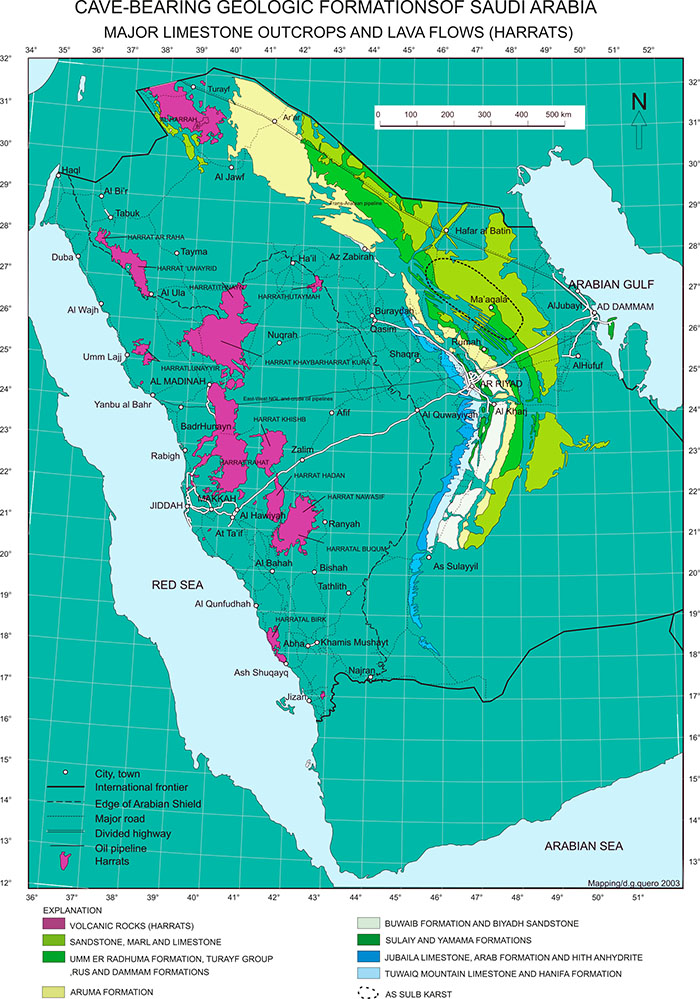 Figure 1, Cave-Bearing Geologic
Formations of Saudi Arabia
Beginning in November, 2001, the Cave Unit of the Saudi Geological Survey located, mapped and described volcanic caves in several lava fields located on the Arabian Shield (Pint, 2006). Remarkably well-preserved bones, scat and artifacts were found in both limestone and lava caves in many areas of Saudi Arabia. An example of such a limestone cave is Murubbeh or Shawiah Cave (designated B7 Cave by Benischke and others) in whose deepest recesses a temperature of 16.7° C was measured, unusually cool for a cave on the Summan Plateau. Two human skulls, many bones, countless hyena coprolites, an animal-skin “blanket” and the naturally mummified body of an Arabian Red Fox, Vulpes vulpes arabica (Fig. 2), were discovered in this cave located 200 kilometers northeast of Riyadh. The well preserved fox was brought all the way to the Natural History Museum in London for identification and was carbon dated at 1890 years by ETH, the same Swiss lab that dated the Iceman. 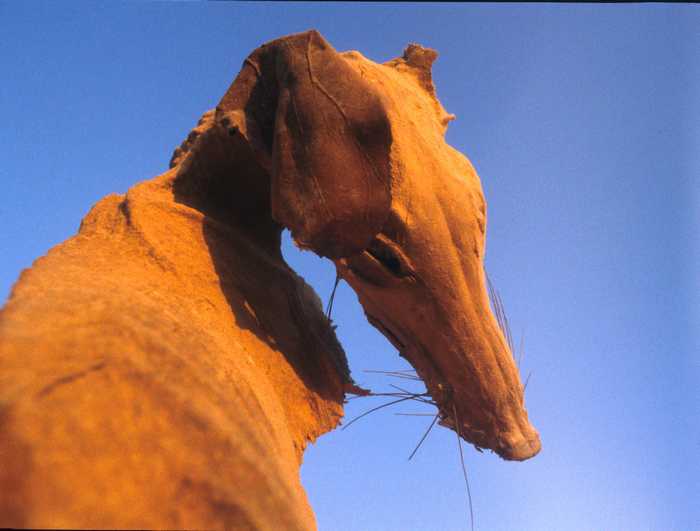 Figure 2, Nearly 2000-year-old
Arabian Red Fox
One of the largest caches of well-conserved, mixed bones (Fig. 3) was found in Serdab al Aqrab al Aswad (Black Scorpion Cave) near the border with Iraq. The bones were presumably carried into the cave by hyenas, wolves and foxes, as suggested by great quantities of their scat, also very well preserved (Al-Shanti and others, 2002). 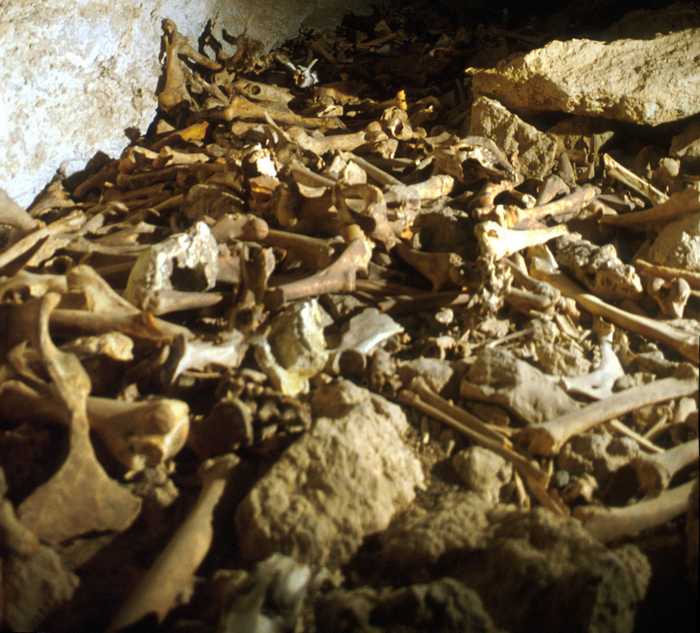 Figure 3, Cache of mixed bones in
Black Scorpion Cave
Two possibly Neolithic throwing sticks (Fig. 4) were found in Kahf al Ashbaah (Ghostly Cave), a lava tube in Harrat Kishb, but were not dated (Roobol and others, 2002). 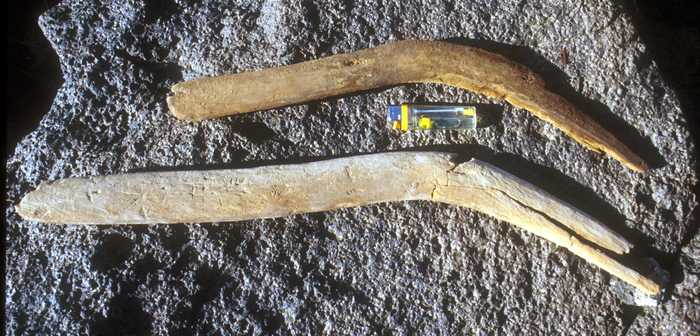 Figure 4, Throwing Sticks
discovered in Ghostly Cave
The oldest bones found in a Saudi Cave and dated, were discovered at the distal end of the Wolf Den Passage of Umm Jirsan Cave. Two fragments of human skulls (Fig. 5), carbon-dated at 4040±30 and 3410±30 years BP were found lying on the surface of a sediment floor measured 1.2 meters deep in another part of the cave. It is speculated that digging may result in the discovery of even older bones in this cave. Numerous basalt geofacts (Fig. 6) of a size and shape useful for cutting, scraping and puncturing, were found gathered together in the Workshop Passage of Umm Jirsan Cave. These may have been used as tools (Pint, 2009). 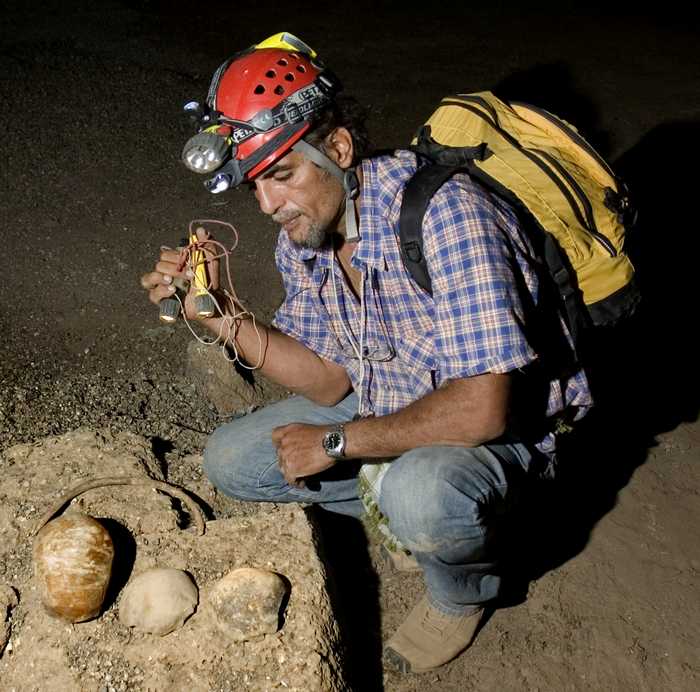 Figure 5, Fragments of three
human skulls found in Umm Jirsan Cave
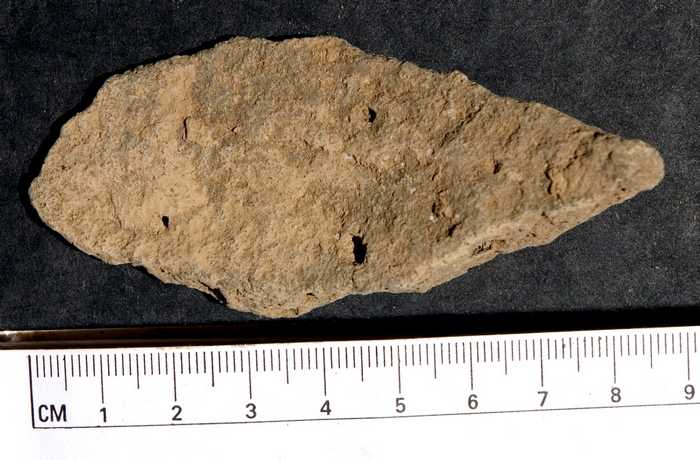 Figure 6, One of many pointed or
sharp-edged basalt fragments in Umm Jirsan Cave
Umm Jirsan Cave is located inside Harrat Khaybar, a lava field covering some 12,000 square kilometers with lava flows ranging in age from five million years to historic. Roobol and Camp (1991) report ancient structures within the borders of Harrat Khaybar and Kennedy (2012) estimates there are remains of 500 kites in this lava field, presumably used to trap animals. The National Geographic Genographic Project suggests that many ancestors of modern human beings left Africa via the Bab-el-Mandeb Strait on the Red Sea and migrated north through the Arabian Peninsula some 60,000 to 70,000 years ago. These people would have found shelter from heat, cold and wind—and in some cases potable water—inside caves located within the lava fields along their route. The same may be said for travelers along ancient roads such as the Old Incense Caravan Trail and the Dharb al Zubaydah (Fig. 7). 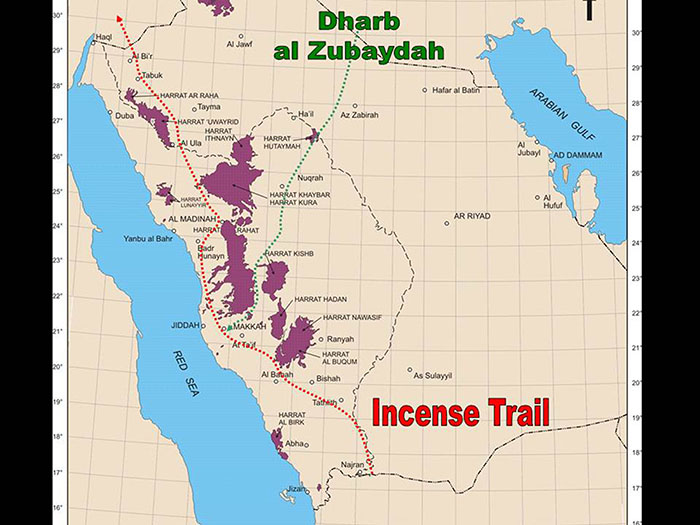 Figure 7 Ancient trails skirted
the harrats (lava fields) of western Saudi Arabia
The oldest bones found in any Saudi cave were discovered lying on the surface of the sediment-covered floor of Umm Jirsan Cave. This cave is represented on the Geologic Map of Harrat Khaybar (Roobol and Camp, 1991) as a series of three dots, representing the three collapse entrances to the lava tube. This same map shows at least 40 more lava tubes in Harrat Khaybar, represented by strings of dots sometimes 20 kilometers in length. Supposing an average length of 10 kilometers per string, the authors estimate that Harrat Khaybar could have over 400 kilometers of unexplored lava-tube passages. It should be noted that Roobol and Camp’s map is based on observations made from low-flying aircraft. Cave exploration is by its very nature dangerous and the location and exploration of lava tubes is even more dangerous and difficult. It is for these reasons that the discovery and mapping of caves all over the world has frequently been carried out by volunteers, not by geological surveys or government-appointed bodies. Societies and clubs dedicated to cave exploration and study can be found in many countries and most are members of UIS, the International Union of Speleology. International teams of cave explorers seek out caves all over the world and survey and map them, the more difficult the cave, the better. These teams are composed of highly skilled and highly motivated cavers who normally receive no monetary compensation for their achievements, which are perceived as sport rather than work. The UIS Commission on Volcanic Caves, established in 1993, can assist archaeologists in Saudi Arabia by organizing a team of highly skilled volunteers to locate and investigate lava tubes in order to list those with archaeological, historical, biological, microbiological and mineralogical potential, thus smoothing the way for later visits by scientists in the appropriate field. Given the high potential of Saudi lava tubes for housing traces of Early Man’s passing and the ease with which exploration could be organized by a UIS-approved team, the future of archaeological studies in the Kingdom of Saudi Arabia seems bright indeed. REFERENCES Peters, Pint and Kremla, 1990: Karst Landforms in the Kingdom of Saudi Arabia. NATIONAL SPELEOLOGICAL SOCIETY BULLETIN, June 1990, pp. 21-32. Benischke, R., Fuchs, G. & Weissensteiner V., 1991: Karstphenomena of the Arabian Shelf Platform and Their Influence on Underground Aquifers, Speleological Investigations in the Shawyah-Ma’aqla Region, Eastern Province, Saudi Arabia. Austrian Academy of Sciences and King Fahd University of Petroleum and Minerals Roobol, M.J. and Camp, V.E., 1991: Geologic map of the Cenozoic lava field of Harrats Khaybar, Ithnayn, and Kura, Kingdom of Saudi Arabia. Saudi Directorate General of Mineral Resources Geoscience Map GM-131, with explanatory text. Al-Shanti, M.A., Pint, J.J., Al-Juaid, A.J., Al-Amoudi, S.A., 2002: Preliminary Survey for Caves in the Habakah Region of the Kingdom of Saudi Arabia. Saudi Geological Survey Open-File report SGS-OF-2003-3, 32 p., 43 figs. Roobol, M.J., Pint, J.J., Al-Shanti, M.A., Al-Juaid, A.J., Al-Amoudi, S.A., and Pint, S., With the collaboration of Al-Eisa, A.M., Allam, F., Al-Sulaimani, G.S., and Banakhar, A.S., 2002: Preliminary Survey for Lava-Tube Caves on Harrat Kishb, Kingdom of Saudi Arabia: Saudi Geological Survey Open-File report SGS-OF-2002-3, 35 p., 41 figs, 1 table, 4 apps., 2 plates. Pint, John J., 2006: Vulcanospeleology in Saudi Arabia. Acta Carsologica, 35/1, Ljubljana, pp. 107-109. Pint, John J., 2009: Umm Jirsan: Arabia's longest lava-tube system. UIS Commission on Volcanic Caves, Proceedings, 15th International Congress of Speleology, July 2009, Kerrville, Texas, pp. 714-717. Kennedy, David, 2012: Kites—new discoveries and a new type. Arabian Archaeology and epigraphy, 2012-23. pp. 145-155. |